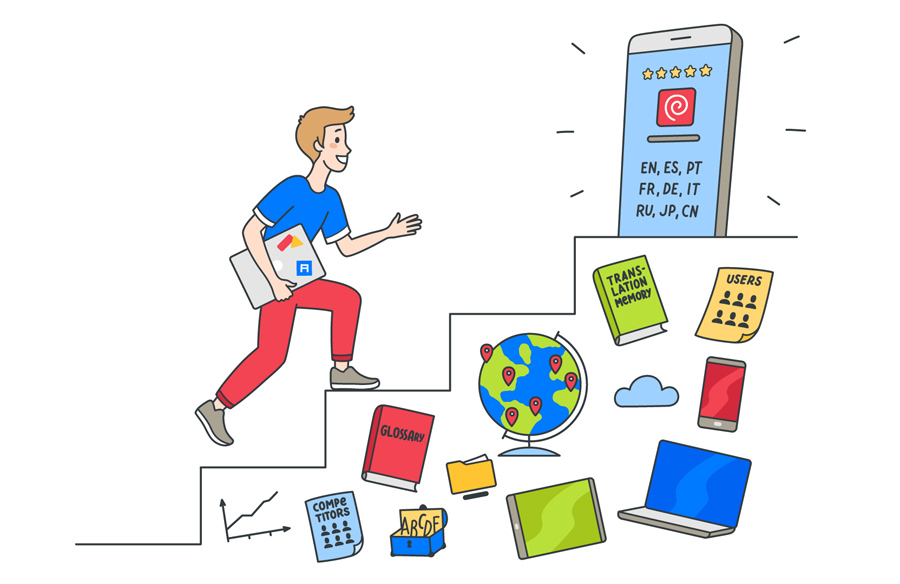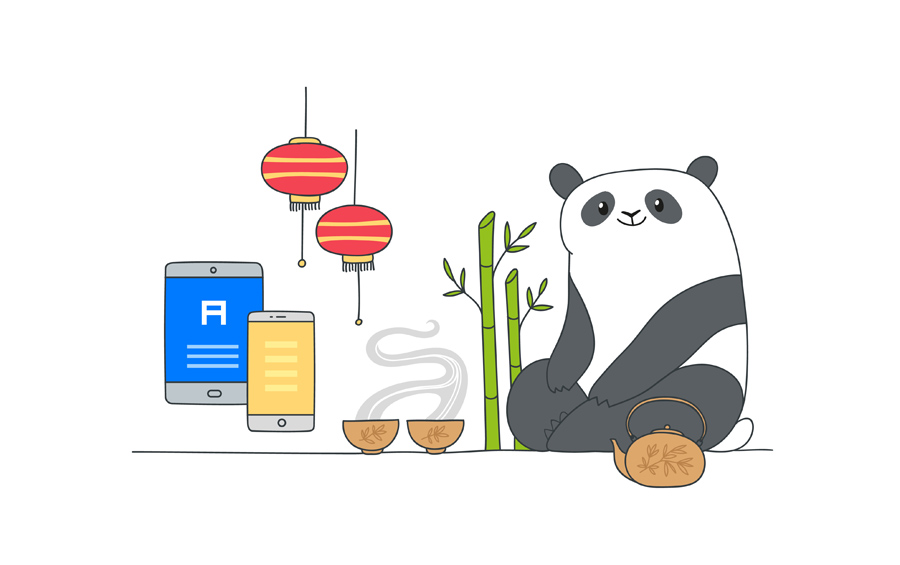According to predictions of the analytical platform App Annie, interest in mobile apps will enjoy stable growth over the next four years. So, if you’re considering bringing your app to new markets, this is the time to do it.
During my two years as the localization manager, I came to understand that localization has its own rules, and knowing them can help you adapt any product for a new market quickly and competently. These principles will be useful for anyone who wants to localize an app but doesn’t know where to start.
1. Evaluate the potential
Start with the most important thing: figuring out which languages you need to localize your app into and determining whether or not localization is justified at all.
Here’s an example from my experience: Israel isn't a high-priority market for Badoo, but the app is localized into modern Hebrew. Moreover, only 6% of Israeli Badoo users actually run the app in Hebrew (as a comparison, 62.5% of Israeli users speak English). In this particular case, localization is justified even with these statistics, but a similar situation could represent a losing proposition for your app. So, study your market.
If you’ve got the ability to analyze statistics and evaluate whether or not your expenses will be recouped, great. It's entirely possible that your users are satisfied with the current version of the app and aren’t all that concerned about not being able to use it in their native language. This applies primarily to European countries where the overwhelming majority of young users are proficient in English. The same goes for dialects. Maybe European Spanish will be enough for all your Spanish-speaking markets (at least at first).
This doesn’t mean you should cut corners on localization wherever you can. If you’re planning to expand to, say, the Korean market and are launching several major PR campaigns there, getting by without a Korean localization isn’t an option.
But keep in mind that your app will change its design and acquire new functionality over time. And the more languages you support, the more you’re going to spend on localization. In other words, before you start up the localization machine, make sure you’re not doing it for fifteen dedicated users.
2. Know your user
Chances are, you did this before launching your app, but during the localization phase this point becomes exponentially more important.
How old is your user? Are they male or female? What is their social status? The more you know about your users, the easier things will be for the localization team.
Your user is probably a mixed breed, so figure out which social group is the defining one for your app. Is it users who are willing to purchase paid services, subscriptions, and the like? Or is it active users who will make your app go viral? Is it young moms? College students? Athletes?
This point is somewhat less important for English, but if you’re translating your app into Russian or French, you’ll quickly run into dozens of the most varied questions. How should you address the user: formally or informally? Can you kid around with them? Can you send them emoji? Do they need emotional support? Or, on the contrary, do they just need minimal text with maximal functionality?
It hardly makes sense to support several different versions of your app, just so every single user can be equally comfortable running it. So, the more questions you ask right off the bat, the better your localized product will be in the end. And, by extension, the less often your users will want to delete it or write a negative review in a store or on social media.
3. Tidy up
You probably already have a glossary — you know, a list of terms used in your app. Well, this is the time to bring it out, update it, and hand it over to the localization team. You’re going to need a glossary for each language, and it should be regularly updated. Otherwise, you’ll run the risk of having your app drown in a quagmire of inconsistency every time you switch translators. A glossary usually includes names of menu sections and features, currency, crucial actions (swipe, like, stream), etc.
But there’s also another, equally important document: the style guide. It defines the tone of the app, including words to avoid and general rules for the visual appearance of the text. In English, the style guide might standardize issues such as capitalization, comma usage, types of ellipses, the use of hyphens versus em dashes, etc. It’s an important document that helps the translator choose the tools that work while laying all the other ones aside.
Once both of these documents are ready, share them with the folks in charge of advertising campaigns, press releases, and SMM promotion to ensure consistency. You actually don’t want your ads to be completely tonally consistent with the app itself — ads are always more aggressive and dynamic. But make sure the contrast between the ads and the app isn’t going to shock an unprepared user.
These things might seem obvious, but they're often overlooked. An app that is translated inconsistently by multiple people (whether simultaneously or consecutively) produces the impression of a slapdash product cobbled together on the fly — even if the design of the app itself is beyond reproach.
4. Take a look at the competition
Ask your localizers to research potential competition on the market. Or, even better, do it yourself (if you have the language skills). Chances are you've already studied your potential competitors, but you probably haven’t analyzed the quality of their localizations.
Why not ask your localizers to tell you exactly what they like or don’t like about these apps? You can ask them to focus on products that were originally written in the language you’re interested in — as a rule, they’ll be of a higher linguistic quality. Keep an eye on competing apps’ main problems — you might be able to turn their weaknesses into your strengths.
5. Take cultural factors into account
This is a good time to reiterate that machine translation will never, ever be able to replace a localization expert. Preferably, this person was born, raised, and still lives in the country for which you’re adapting your product. Forget about virtuosos who say they can translate an app into eight languages by themselves. Those guys are good for translating legal documents and instructions, not software. You need a native speaker, plain and simple. Your ultimate goal is for your user to completely forget that your product has been translated. At the very least, you want to make sure your app doesn’t confuse, embarrass, or frighten them.
These kinds of reactions can be brought about by things you never even considered: the colors used in your app, the topics discussed in it, or terms you want to leave untranslated. For example, in Italy the color purple is inextricably associated with funerals. This doesn’t mean that you need to redesign your entire app right away. Just be ready for the statistics in Italy to be worse than you expected. Keep in mind that something that is legal and acceptable in one culture could be unacceptable in another. So, while the question “do you smoke pot?” might be just peachy in Canada, it could lead to dire consequences in a number of other countries.
Here’s an example from my experience: the team behind Bumble (one of Badoo products) called one of their features “Beeline” and wanted to leave the name the same in all markets. They didn't consider the fact that some countries have, a priori, a very low tolerance for Latin letters (Asian countries, for example). So, it’s best to avoid English terms altogether in these markets. In Russia, on the other hand, there’s already a popular mobile operator called Beeline, so the product team had to rename the feature there.
6. Think about how much space the translation can take up
If your app was originally written in Russian, you probably don’t have to worry about this. But if it was written in English, you’ll want to pay attention to this point. Keep in mind that the German version will be on average 10% longer than the original, the Russian version will be 50% longer, and the Arabic version will be a whopping 75% longer. Please note, we’re not talking about the total number of characters but about bytes. One Latin letter equals one byte, but Cyrillic and Arabic characters are twice as big.
Sure, you can always try to make the translation shorter and punchier. But then you run the risk of ending up with a product that communicates with your user in monosyllables. So, be prepared for the fact that, for the sake of a good localization, you’ll need to make changes to your design and code.
For example, there are a lot of compound words in German and Finnish that might not fit on a single line in small UI elements.
7. Decide on a standard screen
As a follow-up to the last point, I suggest analyzing which devices your users prefer. We aren’t talking about their platform of choice here as much as the actual model of the phone they use. As a rule, large apps are designed for the tiniest screens possible. The logic is actually pretty straightforward: something that looks good on an iPhone 5 will definitely look good on an iPhone X.
If your app is going to be used on devices with small screens, steer clear of them while writing copy and testing. No one likes an app where half the text wanders off into the wild blue yonder. Especially if that’s where you’re selling one of your services or communicating something important.
8. Speak human
Start off by thinking about how to integrate the ability to manage case ending and conjugations into your app, and set a place aside for male and female users.
There are way more languages that need this than you might think — we aren’t just talking about Russian and a handful of other Slavic languages. You’re going to need this kind of adaptation to at least some degree for French, Spanish, Portuguese, Finnish...
Can you get by without it? Maybe. Even Facebook sometimes ignores declensions and conjugations. But the quality of the product absolutely suffers because of this.
Don’t expect miracles from your localizer — if there are any dynamic numbers in your app, make it possible to use the correct form of the noun with them. If your app features interaction among users, divide your lexical elements based on gender. If your app involves any kind of social network, decline first names and the names of countries and cities. This won’t cover cases where users call themselves Candy or Superman, but it’ll cover the other 95%.
9. Evaluate quality
Think about how you’re going to evaluate the success of your localization. In addition to localizers, it’s a good idea to have independent reviewers who will be able to give you an objective evaluation of the work the localizers have done. If you aren’t able to pay reviewers on a regular basis, you could do a random check of 10-15 screenshots. At least for your main languages. At least once a year.
One less obvious – and free – way to check the quality of your localization is user feedback. Look at the percentage of complaints connected to the incorrect or incomprehensible text. If half of your complaints are language-related in one way or another, it’s time to find a reviewer.
Evaluating localization quality based on statistical data is tricky because there are also cultural factors at play here. Let’s say you decide to measure the number of opened push notifications in Spain and France. In the overwhelming majority of cases conversion will be higher in Spain than in France. And this has nothing to do with localization quality. It’s just that, for cultural reasons, Spanish people tend to open every notification they get, while French people, on the contrary, ignore most of their notifications. The same thing can happen with the cultural reception of certain features and services.
10. Test everything
Make sure you get your localizers to test the app before you launch it. Do this in advance, so they have time to check it, correct it, and retest it. Text in a CAT tool is completely different from text in an Excel document, on paper, or in an app. The context will appear immediately once the app is on-screen. Moreover, sometimes whole scenarios need to be tested step by step. In this way, you can make sure that the logic of the algorithm isn’t violated and the user doesn't suddenly want to quit in the middle of the process.
If your app is updated on a regular basis, you’ll need to test it just as regularly. At Badoo, for instance, new features are tested on all platforms and in all core languages prior to launch. Sure, this takes a lot of time and effort, but, again, you need to ask yourself just how much you care about the quality of your product.
When all is said and done, there is no such thing as a perfect localization, a perfect product, or a perfect design. There is no image or text that will please every single person without exception. You need to know how to separate constructive criticism from nonconstructive complaints and only bring important issues to your localizer’s attention.






amiku
Thanks for contributing. Useful check-list for those who is launching products internationally.